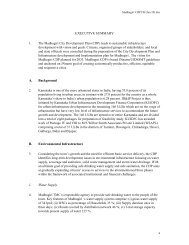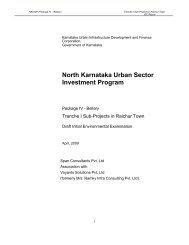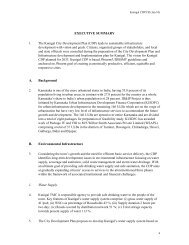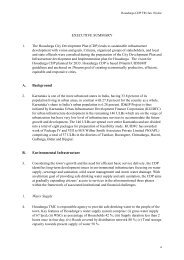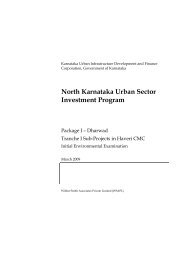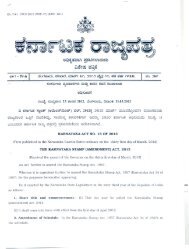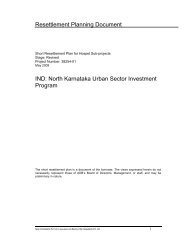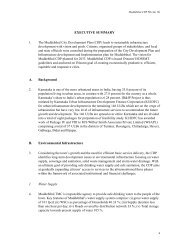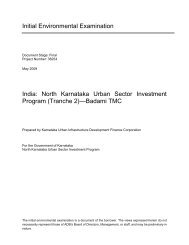KMWEEP-EA Final Report June 3 2008.pdf - kuidfc
KMWEEP-EA Final Report June 3 2008.pdf - kuidfc
KMWEEP-EA Final Report June 3 2008.pdf - kuidfc
Create successful ePaper yourself
Turn your PDF publications into a flip-book with our unique Google optimized e-Paper software.
KARNATAKA MUNICIPAL WATER PUMPING IMPROVEMENTS IN SIX TOWNSENVIRONMENTAL AUDIT AND PREPARING ENVIRONMENTAL MANAGEMENT PLANFINAL REPORTvalues of Hubli.Table A-3: Ambient Air Quality of HubliParameter KC Circle (commercial area)Average value of Ambient airair pollutant quality standardKIMS (sensitive area)Average value ofair pollutantAmbient airqualitystandardµg/m 3 µg/m 3 µg/m 3 µg/m 3TSPM 490.61 360 -- 70RSPM -- 120 173 50Sox 7.88 80 3.60 15Nox 12.45 80 7.20 15Source: KSPCB Annual <strong>Report</strong> 2002 – 03Ecological EnvironmentBeing predominantly an urban area, the ecological environment of Hubli-Dharwad is not verydiverse. A major portion of the twin cities is located on the eastern quadrant of the Dharwaddistrict and this region is characterised by black cotton soil and lower rainfall as compared to thewestern region. Hence mostly shrubs and scattered trees are found in this region. The westernregion outside the city limits, due to its higher rainfall and lateritic soil has remnants of a densedeciduous forest. The monsoon forests covering the western fringe of the district have a variety offlora and fauna, which are not in the influence area of the project area.Socio-Economic EnvironmentThe total population of HDMC is 786,018 as per census 2001. The city has experienced lowpopulation growth during the last two decades (18.3 percent from 1981 to 1991 and 21.2 percent,from 1991 to 2001).The density has increased from 1837 persons per sq.km in 1971 to 3,886persons per sq. km in 2001. While the city’s overall density is quite low, the core, inner areas andsome of the older areas of the city are more densely populated than the fringe areas of the city.The sex ratio (female population per 1,000 male populations) in Hubli-Dharwad is 949, which ishigher than the State urban average of 940 and National urban average of 901. The currentliteracy rate (percentage of literate population to the total population above six years of age) inHDMC is 72.1 percent (the male literacy rate is 77.6 percent and the female literacy rate is 66.4percent) – at par with the State urban average of 71.4 percent and National urban average of70.1 percent.Although the economy of Dharwad district is predominantly agriculture in nature, the primarydrivers of Hubli-Dharwad city’s economy are the trade and commerce, transport and servicesector (mainly industrial units, government jobs). Approximately 55 percent of the city’spopulation is involved in tertiary sector. According to Census 2001, Dharwad district urbanworkforce participation rate (WPR) (percentage of main and marginal workers to the totalpopulation) is 33.18 percent (including 2.5 percent of marginal workers). Hubli-Dharwad urbanWPR in 1991 was 28.03 (including 0.63 percent of marginal workers).A-5 Potential Environmental Impacts and Mitigation MeasuresThe environmental impacts caused due to the urban infrastructure projects can be categorizedeither as primary (direct) or secondary (indirect) impacts. Primary impacts are those which are23 World Bank



